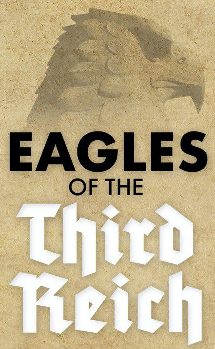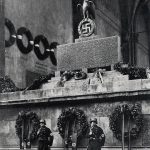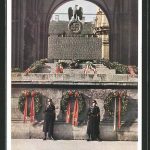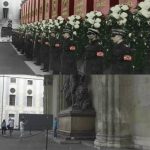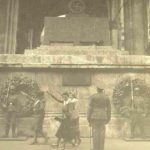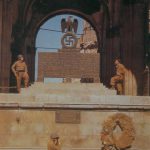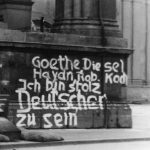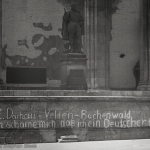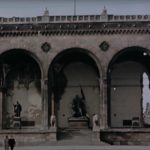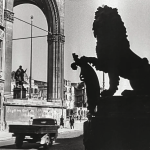 Availability: Unique – only one known
Availability: Unique – only one known
Location today: The monument was destroyed after the war and the bronze recycled (refer below)
Sculptor: Kurt Schmid-Ehmen
History:
The Feldherrnhalle became famous as the site of a skirmish between the Bavarian police and followers of Adolf Hitler. On Sunday, November 9th, 1923, approximately 2,000 Hitler supporters organised an illegal march down the Ludwigstrasse towards the Feldherrnhalle to start the so-called ‘people’s revolution’. The state police ordered the marchers to stop and when they failed to do so, the police opened fire and killed 16 marchers. Four policemen were also killed during the clash and many others were wounded. Following the skirmish, Hitler was arrested and sent to prison to serve a short term. The battle between the marchers and the police has come to be known as the Beer Hall Putsch because the march began at the Bürgerbräu Keller, one of the city’s largest beer halls.
In 1933 a memorial to the fallen putschists was erected (the ‘Mahnmal der Bewegung’) on the east side of the Feldherrnhalle, opposite the spot in the street where the dead had fallen and the putsch had been halted. The memorial, designed by architect Paul Ludwig Troost and executed by sculptor Kurt Schmid-Ehmen, bore the names of the sixteen “martyrs of the movement” who were killed on 9 November 1923 (fourteen here at the Feldherrnhalle and two others at the War Ministry).
The martyrs listed on the monument are:
- Felix Allfarth
- Andreas Bauriedl
- Theodor Casella
- Wilhelm Ehrlich
- Martin Faust
- Anton Hechenberger
- Oskar Körner
- Karl Kuhn
- Karl Laforce
- Kurt Neubauer
- Klaus von Pape
- Theodor von der Pfordten
- Johann Rickmers
- Max Erwin von Scheubner-Richter
- Lorenz Ritter von Stransky-Griffenfeld
- Wilhelm Wolf, businessman
The back of the monument bore the slogan “Und Ihr habt doch gesiegt!,” which was from a speech by Hitler and can be translated ‘And yet you triumphed!’. During the Third Reich, SS men constantly guarded the monument, demanding the outstreched arm and accompanying salute known as the ‘Hitlergruss’ from passerby as a gesture of respect. Since citizens who refused this gesture were harassed, some began to avoid walking by the monument altogether by cutting through the Viscardigasse immediately behind it, which soon acquired the name ‘Drückberger-Gassl’, or Shirkers’ Alley. In 1995 a floor installation “Arguments” by Bruno Wank was installed to commemorate those who used Viscardigasse behind the Feldherrnhalle during National Socialism to avoid the Hitler salute at the Nazi memorial.
The memorial measured 3 meters wide and 3,5 meters high, including the ‘Steinadler’ by Kurt Schmid-Ehmen on top.
On the side of the Felderrnhalle there was an original plaque placed for the four Bavarian police officers killed in the Beer Hall Putsch. This original plaque was removed and its fate is unknown although most likely recycled like the monument itself. It read: SS Und vonder landespolizei Friedrich Fink Nikolaus Hollweg Max Schobert Rudolf Schraut (‘SS And from the state police Friedrich Fink, Nikolaus Hollweg, Max Schobert, Rudolf Schraut’).
Design pics:
Pre-War pics:
Post-War pics:
After the war (in May, 1945) the northern side was graffitied with the text “KZ Dachau – Velden – Buchenwald / Ich schäme mich, daß ich ein Deutscher bin” (I’m ashamed that I’m a German). On the east side it was graffitied with the text “Goethe Diesel Haydn, Rob. Koch Ich bin stolz Deutscher zu sein” (I’m proud to be German). A poster (“Wessen Schuld?”) roughly translated as “Whose Fault?” was affixed to the northern face. This poster showed pictures of victims of the various German camps.
The monument was dismantled by the American government (in June, 1945). It was pushed off the main Felderrnhalle monument where it sustained damage upon hitting the walkway below. The swastika was partly detached from the main monument and the eagle Was broken off at the legs. At some point the eagles head was removed and the damaged eagle strung from one of the hooks on the Felderrnhalle. The monument can also be seen to the left of the graffiti in the pictures below.
On June 3, 1945, the monuments bronze was recycled and used in the reconstruction of the Residenz. It was melted down and elements of the “Patrona Boiariae”, the figure of Mary on the facade of the residence, were cast from the bronze.
Police Plaques:

Today a small bronze plaque added to the pavement in front of the Felderrnhalle in 2010 commemorates the four policemen killed in the attempted putsch. The new plaque reads:
Den Mitgliedern der Bayerischen Landespolizei, die beim Einsatz gegen die Nationalsozialistischen Putschisten am 9.11.1923 Ihr Leben ließen. (‘To the members of the Bavarian Police, who gave their lives opposing the National Socialist coup on 9 November 1923:…’)
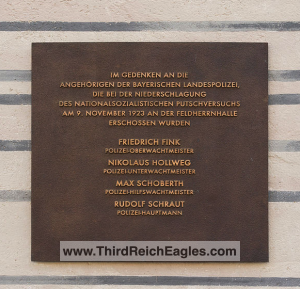 There is also an additional one on the wall of the Residenz in memory of the Bavarian police killed. It reads:
There is also an additional one on the wall of the Residenz in memory of the Bavarian police killed. It reads:
Im gedenken an die angehorigen der bayerischen landespolizei, die bei der niederschlagung des nationalsozialistischen putschversuchs am 9. NOVEMBER 1923 an der felderrnhalle erschossen wurden. (‘In memory of the members of the Bavarian State Police, who were shot at the Feldrnhalle on November 9, 1923, when the National Socialist attempted coup was suppressed’)
Other resources:
